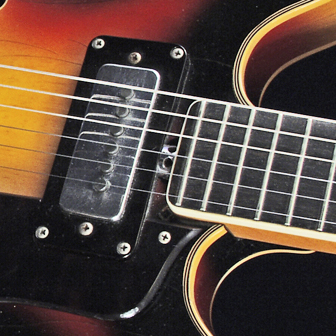
Vox Ultrasonic description | sound clips | Ultrasonic XII


Front and rear views of a late sixties Vox Ultrasonic. The protective pad that clips to the rear of the body covers the access panel
The Vox Ultrasonic, or V268, was one of Vox's late sixties semi acoustic models sporting built in electronic effects. It was modelled on the thinline semi acoustic models such as the Gibson ES335, but without the set neck (it was a bolt-on), and central maple block (it was completely hollow). This made it more akin to guitars such as the Fender Coronado or Hagstom Viking, but with its own unique features - teardrop headstock, and built in effects.
The original Vox literature describes the Ultrasonic as follows:
“A beautiful double cutaway electric acoustic guitar. Has built-in E tuner, distortion booster, treble and bass booster, Wah-Wah, repeat percussion. Has a completely new Vox easy-to-fret fast-neck with the famous Vox double T-bar and adjustable steel rod. Two exclusive Vox Ferro-sonic pickups for wide range high fidelity, Has new positive action adjustable spring tremolo. ”
They were produced at the E.M.E (Elettronica Musicale Europea) factory in Recanati from 1967, and feature a 'made in Italy' decal on the reverse of the headstock. It came in 6 and twelve string versions (the twelve string, Ultrasonic XII V275 had a slightly different shaped headstock, and headstock markings) and in two colours, cherry and sunburst. As a high end model, it featured block inlays, front and back binding and headstock ornamentations not seen on other models.
The built in effects are rather interesting, consisting of an E-tuner (plays a quiet E note), treble/bass boost, distortion (mild overdrive to full blown 60s fuzz), repeater, and palm-operated wah wah pedal. They are powered by a 9V battery accessible through a circular cover under the pad at the rear of the body. An identical model with the exception of having no wah wah was also produced; the V267 Cheetah, and with no tremolo the V289 Viper.
Vox Ultrasonic V268 - A wild new happening from Vox: electronic guitars! One of the first adverts for the Vox built-in guitar effects. This one features the Vox Ultrasonic.
“The world's first guitars with built-in distortion, Wah-Wah, E or G tuner, bass and treble boosters; even repeat percussion. Puts everything right at your fingertips. Lets you work free from the amp—away from footswitches. Just flick a switch on the guitar for distortion. Flick another to boost bass or treble. Other switches control Wah-Wah, repeat percussion and the built-in tuner. There's never been anything like Vox electronic guitars. Their necks are super fast. Their Ferro-Sonic pickups lay out incredible sounds. There are bass, six and twelve string models — in a gang of shapes; choice of effects. Vox electronic guitars. At your Vox dealer's now. Take the trip. Play Vox: it's what's happening.”
These effects are broadly similar to the Vox effect pedals available in the mid to late sixties, and all can be heard on the Vox Ultrasonic sound clips page. Each has an on/off switch, and all (with the exception of the wah-wah) have a control. This sets the speed for the repeater, level of fuzz for the distortion, and bass/treble response for the boost. When combined, an amazing array of psychedelic sounds can be produced without really playing the guitar at all - just letting it feed back on itself. The least useful of all the effects is the wah wah - not because there is anything wrong with it, just that it is considerably more difficult to operate than a foot pedal (you push the triangluar lever with the palm of your picking hand).






Catfish Collins plays a solo on his Vox Ultrasonic with James Brown and Brother Bootsy (in the back row). Live in Paris 1972. Fantastic! Click the central arrow to play the video
The most famous user is Catfish Collins, brother of Bootsy Collins who can be seen getting down with this funky guitar on performances with James Brown - right (live at Olympia, Paris 1972), and shortly afterwards with George Clintons Funkadelic.
£4587
€349